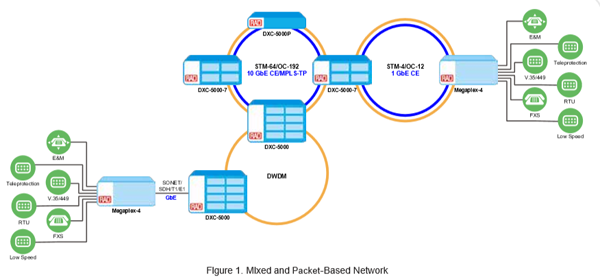
RAD
DXC-5 DXC-5000 High Capacity Cross-Connect

Key features RAD DXC-5000 High Capacity Hybrid Cross-Connect include:
- High density Ethernet/SDH/SONET
- MPLS-TP and Traffic-Engineered Pseudowires
- Synchronization: BITS, SyncE
- High capacity: STM-64/OC-192, 10 GbE
- Sub-50ms protection: 1:1, BLSR, PW, ERPS
- Carrier Ethernet: CE 2.0 Certified
- Optional TDM circuit emulation
RAD DXC-5000 balances TDM and packet transport in a way unique to the industry. Its hybrid architecture allows for three transport modes: TDM-over-packet transport, hybrid TDM and packet transport, and all packet transport, based on identical hardware, software and features. This flexibility creates a unique opportunity for network designs, by optimizing every service based on the service requirements, without the limitations of a particular technology. In addition, DXC-5000 from RAD reduces operations costs by using a single platform for these service requirements and avoiding the need for multiple devices at any site.
When compared to the life cycle costs of separate TDM and packet networks, DXC5000 reduces power consumption, software costs, training costs and the number of modules. Network utilization is also improved by using the full bandwidth of the packet and TDM transport.
Packet and E1/T1 services can be transported over Ethernet or SDH/SONET. Since each slot can directly access the Packet and TDM switches at the same time, services can be matched to best technology whether that is maximizing efficiency with statistical multiplexing or minimizing latency. This slot flexibility has the benefit that each port on each module can be individually routed via software to the appropriate switch reducing operations costs.
DXC-5000’s transport flexibility ensures the lowest transport cost per bit. With the ability to perform statistical multiplexing, low cost TDM switching and DWDM in the same device, new services can use the lowest cost infrastructure across the entire network. By matching the service interface to the best switch and the best transport method (Ethernet or SDH/SONET), each service can be delivered with the lowest latency required.
ETHERNET CAPABILITIES OF THE RAD DXC-5000
DXC-5000 provides best-in-class packet switching to create networks with the highest performance. Ingress rate limiting prevents any service or application from congesting/choking the network. Each packet is classified so that the appropriate network policies (like prioritization and scheduling) can be applied. Eight CoS queues and scheduling algorithms ensure that there are sufficient resources available to manage the data traffic efficiently. Standard G.8032 ERPS (Ethernet Ring Protection Switching) provides sub-50ms protected packet rings for greater resiliency. Multiple ringlets and multiple ring topologies are supported.
Ethernet OAM allows real-time monitoring of end-to-end circuits, connections or trunks, enabling quick detection and isolation of faults to a particular subnet, trunk, link or node. DXC-5000 features BFD-based Fault OAM and ping/traceroute at tunnel/pseudowire level. For 802.1q/802.1ad-based MEF services, DXC5000 supports Y.1731/802.1ag-based CFM OAM (Port level down MEP) and Y.1731 PM counters.
RAD DXC-5000 CIRCUIT EMULATION
Even though many services and applications move from TDM to packet, a few TDM circuits will remain in the network. Circuit emulation provides an alternative transport method using an all Packet Transport Network. DXC-5000 employs E1/T1 SAToP and STM-1/OC-3 CEP for carrying this traffic with the reliability and protection mechanisms of legacy TDM networks, including card level protection for E1/T1 interfaces.
OTN ON RAD DXC5000
DXC-5000 uses OTN technology to increase optical span length with Forward Error Correction (FEC), optimize bandwidth utilization for high bandwidth Ethernet requirements and reduce latency in networks with many nodes. OTN switching reduces the cost of high-speed transport throughout the network and DXC-5000 provides the aggregation/on-ramp to the OTN core network.
SDH/SONET
Featuring a complete suite of SDH/SONET capabilities, DXC-5000 provides the reliability and performance expected of your transport network: predictable latency, low protection switching times, deterministic routes and manageable bandwidth.
MPLS-TP
MPLS label-based Connection Oriented Ethernet allows packet traffic to be easily and precisely routed through the network. DXC-5000 provides MPLS-TP-based pseudowires for traffic engineered flows on trunks, which optimizes the network by providing the right amount of control. The cost benefits of statistical mutiplexing are combined with traffic engineering and capacity planning to lower CAPEX by right sizing the network. OPEX reductions come through faster provisioning, robust protection and quicker root cause analysis during failures. In addition, with mesh protection capabilities latency and protection switch times are minimized.
SYNCHRONIZATION ON RAD DXC-5000
SyncE , DCR, ACR
ARCHITECTURE
RAD DXC-5000 has a flexible architecture that allows it to build the network best suited for all services:
- Linear for rapid deployment
- Hub and spoke for cost effective buildouts at the edge of the network
- Ring and ringlet for high utilization and resiliency
- Meshed for low latency and flexible protection.
This is achieved with a unique combination of functionalities, including the ability for every optical port to be defined as a User to Network Interface (UNI) or a Network to Network Interface (NNI).
The DXC-5000 family includes the following members:
- DXC-5000-7 – Up to 5 tributary and 2 aggregation slots
- DXC-5000-7 with Expansion– Up to 10 tributary and 2 aggregation slots
- DXC-5000P –Non-modular device with predefined assembly options. The assembly options of DXC-5000P are as follows:
- 8xGE optical + 8xGE electrical • 4x10GE optical + 8xGE optical + 8xGE electrical
- 8xGE optical + 8xGE electrical + 16xE1/DS1 + 4xSTM1/OC3 CEM
- 4x10GE + 8xGE optical + 8xGE electrical + 16xE1/DS1 + 4xSTM1/OC3 CEM. 6
MANAGEMENT AND SECURITY ON THE RAD DXC-5000
Point and click technologies for Ethernet and SDH/SONET traffic allow for more accurate service designs, more efficient routing and better fault correlation. Accurate alarming and “fault to affected service mapping” enable fault resolution prioritization. Enhanced network element backups and simple remote software upgrades reduce operational costs while enhancing reliability. NMS server redundancy and geographical diversity ensure faster disaster recovery.
